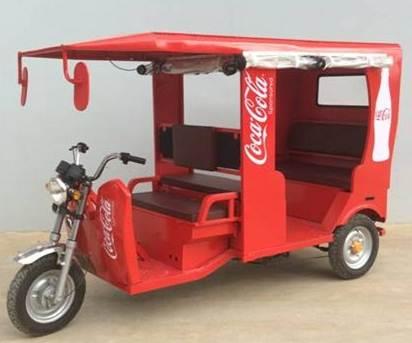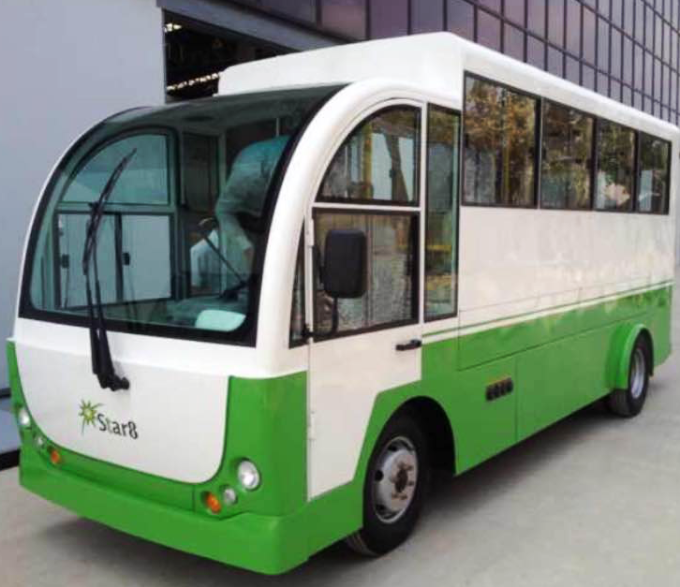Monday, 01/12/2025 | 19:01 GMT+7
"The whole country has now accepted that every day, you will be without electricity for a period of time," said Phil Stone, general manager of Star 8, an Australia-based company that opened up a warehouse and showroom to bring more solar power to the country in 2014.
Star 8 is one of the latest solar companies to set up shop in Cambodia, a country of eight million people, nestled between Thailand, Vietnam and Laos. WIth its proximity to the equator and solar irradiance, Stone said the country is attractive for solar businesses.
"The market in Cambodia is screaming out for an alternative to grid supplied power," he said.

Star 8 has created and manufactured Cambodia's first solar-powered tuk-tuk, the ubiquitous mode of transportation used throughout southeast Asia. A non-governmental organization called Aziza's Place started using the country's first solar-powered tuk-tuk for its mobile coffee cart that employs women who previously worked on hazardous waste dumps.
The idea for solar-powered tuk-tuks, Stone said, came to Star 8 founder Jacob Maimon as he was traveling to the beach in the Cambodian coastal city of Sihanoukville. While riding in a tuk-tuk, the driver asked him to pay half of the $2 fare along the way so the driver could stop and buy more petrol. Maimon eventually learned that the driver earned about $15 per day in fares, but spent $12 of that on petrol. Another $7 per day would make a big difference, Stone said, and thus, the idea for the solar-powered tuk-tuk was born.
Available in four different varieties, Stone said the concept has been well-received so far, even with the price tag: each tuk-tuk starts at about $3,000, a large sum of money for the average tuk-tuk driver. But Stone said microfinance companies are interested in setting up small loans for individuals interested, and many large corporations including Coca Cola, Dutch Mills and Nestles are using the tuk-tuks for deliveries.

Star 8 has also build upon the solar-powered tuk-tuk idea to create solar buses for trial use in Phnom Penh. Buses will soon be launched on the streets of Siem Reap and Sihanoukville as well. "The benefits to the Cambodian people is a huge reduction in pollution levels," Stone said. "If you take that amount of combustion engines off the road, the reduction in emissions will be evident straight away." Reducing the noise pollution will also be a noticeable benefit, he added, and manufacturing the buses in Phnom Penh will create new opportunities for employment.
The company build a three-story warehouse and showroom in Phnom Penh. The warehouse features more than 1,350 solar glass panels on the facade. The showroom, meanwhile, which is totally self-sufficient, has approximately 200 colored solar glass windows and almost 600 solar roof tiles.
"The future for solar in Cambodia is very bright," Stone said, adding that the government must address a few issues before solar becomes widespread, however. A feed in tariff policy must pass and awareness and education campaigns must continue.
Solar Power in Rural Cambodia
While Star 8 is known for working to bring solar-power transportation to urban areas in Cambodia, other companies are focusing on products for villages in rural Cambodia.
Peter Banwell started Cambodia's first solar-power company, Khmer Solar, back in 1997 after moving to the country from the U.S. with his wife and two children. He notes that solar panel prices costs about 25 percent less now than they did back in 1997-2007, and there are now about 25 solar companies in the market.
"The country is growing fast, one of the fastest in Asia, and rice prices are also increasing quickly," he said. "This means that there are more people who can afford solar."
Having reliable electricity in rural Cambodia will forever change lives and create endless potential. "Reliable electricity means that the day does not end at 6:30 p.m.," Banwell said.

Kamworks, which started after one of the co-founders visited Cambodia in 1999 and saw there was a need for solar power, found that about 1.6 million of the 2.3 million families in rural Cambodia depend on battery chargers and kerosene lightning in their homes. This is both dangerous and costly, said Jeroen Verschelling, chairman and one of three co-founders of Kamworks.
In conjunction with Delft University in the Netherlands, Kamworks developed the MoonLight solar lantern for use in rural areas. Four students came to Cambodia and lived in off-grid areas for four months to see firsthand how villagers used kerosene and car batteries and what lighting needs the families had.
"After initial research, the students developed four prototypes and let the villagers choose the product that they liked the most. That was the MoonLight," Verschelling said. Kamworks then started designing and engineering the product, and a year later, distributed MoonLights to the villagers who contributed to the project. The MoonLight solar lantern has a solar panel that can be put on the roof and connected to the lamp, which hangs inside the house to charge during the day. At night, the lantern can be used for a variety of outside activities including fishing, hunting, catching frogs and inside activities like reading and cooking, he said.
Kamworks rented out 3,000 MoonLight lanterns to villages, who were charged 300 riel per day, or about 8 cents, which is the same amount they paid for kerosene, Verschelling said. "We trained local village entrepreneurs to select customers who would pay and look after the product well," he said. "In our rental program, poor people did not need to invest, but could rent the lantern at the same cost as their daily expenditure. But they would get much better, brighter and safer light."
The problem, he said, was that the program was too small and would need to run on a larger scale in order to be profitable because of the time and effort to train and equip the local entrepreneurs.
Still, Verschelling believes the solar industry is just developing in Cambodia, especially because off-grid solar can make vulnerable communities more resilient to extreme weather. Though Cambodians living in rural villages are less worried about the climate effects of using solar — they are more focused on day-to-day livelihood,Verschelling said — climate change and its effects can and will play a pivotal role in their lives. "Imagine that a flood or storms wipes out the grid and it takes months to restore it," he said. "Communications will be badly damaged with no power to charge cell phones. Most economic activity will be lost and businesses will go bust without power. If they would have had solar systems, those businesses could have been saved, and lives could have been saved with speedier communications."
But Verschelling noted that solar power is too expensive for appliances that require a lot of energy, like air conditioning units, so businesses requiring a lot of power need a grid or mini-grid. "Currently, we are just observing the dawn of the solar century," he said. "Solar will become much, much bigger."
Mai Linh








 Energy efficiency and sustainable development in textile sector
Energy efficiency and sustainable development in textile sector
 Hoa Phat saves nearly 3,500 billion dong thanks to self-generated electricity
Hoa Phat saves nearly 3,500 billion dong thanks to self-generated electricity
 Enhancing capacity to develop and implement energy efficiency policies at local level
Enhancing capacity to develop and implement energy efficiency policies at local level
 Stanley Vietnam: Targeting a 4% Reduction in Annual Energy Consumption Intensity
Stanley Vietnam: Targeting a 4% Reduction in Annual Energy Consumption Intensity
 Nghe An Industrial Enterprises Proactively Implement Energy-Saving Measures
Nghe An Industrial Enterprises Proactively Implement Energy-Saving Measures
 WEBINAR 1 - Scaling Up Energy Efficiency in Vietnam
WEBINAR 1 - Scaling Up Energy Efficiency in Vietnam
 Bosch Vietnam Plant Benefits from Investment in Energy Efficiency
Bosch Vietnam Plant Benefits from Investment in Energy Efficiency